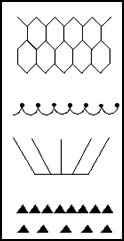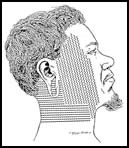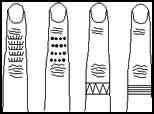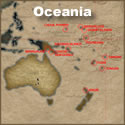The following is an excerpt from the Tattoo History Source Book:
Tattooing in The Marshall Islands
Based on archaeological evident
the first people to settle the atolls which now make up the Republic of the
Marshall Islands arrived between 1000 and 500 BC. Over two millennia after
settlement the first European visitors arrived on the scene and the first
written accounts appear. The first Europeans were a Spanish expedition who
arrived in October 1529 on a return voyage from the Philippines to Mexico. A
brief encounter with the heavily tattooed natives seems to have impressed the
Spaniards so much that they named the entire island group "Les Pintados" - the
painted.
|
|
The first detailed observations of the Marshallese came from a Russian
Exploring Expedition in the years 1816, 1817 and 1824.
German Adelbert von Chamisso,
naturalist on the expedition noted:
"tattooing neither covers nor disfigures the body, but rather blends in
with it in graceful adornment and seems to enhance its beauty." |
By the later part of the 19th century the Marshall Islands became a German
protectorate and tattooing had almost ceased. Christian missionaries felt that
tattooing, traditional attire as well as traditional dancing was heathenism and
should be banned.
Reasons:
• Tattooing was connected with the old traditional way of life and the very
expression of both status and group identity they were set to modify.
• Tattooing was closely interwoven with traditional religious and spiritual
beliefs, and thus 'heathen'.
• Tattooing was perceived o be aesthetically offensive to the European eye.
• In the 19th century both British and US penal systems identified released
convicts and army deserters by their tattoos.
• A Bible reference existed mentioning that the Israelites shall not be tattooed
(Leviticus XIX:28) - hence tattooing was considered un-Christian.
Missionary abhorrence towards tattooing was partially based on the
narrow-mindedness and current ideals of beauty and aesthetics.
Tattooing was banned soon after the missionaries arrived on Ebon. The German
authorities had little to say about tattooing but following the outbreak of WWI,
Japan seized the Marshall Islands from Germany if October of 1914. When the
Japanese authorities took over the Marshall Islands, they banned tattooing.
 A US publication wrote, "In 1922 the Japanese made tattooing or marking of
one's own or another's body a police offense under penalty of enforced labor for
a period not to exceed 30 days. This law may have been an effort to erase the
physical marks of distinction separating chiefs from commoners."
A US publication wrote, "In 1922 the Japanese made tattooing or marking of
one's own or another's body a police offense under penalty of enforced labor for
a period not to exceed 30 days. This law may have been an effort to erase the
physical marks of distinction separating chiefs from commoners."
Traditional Marshallese Tattoos
Many Marshallese tattoo motifs are rooted in the natural marine environment
and are drawn from sea. Many motifs are abstract forms of specific fish. Other
tattooing in general is called eo, which means the drawing of lines in general,
after the lines of the blue-striped or regal angelfish.
Generally, the Marshallese tattoo motifs are very abstract pictographs, their
meaning, finds its roots in the environment: markings of fish, tooth marks or
fish bites, motifs resembling shells.
Motifs were executed in a systematic manner and their arrangement followed
specific patterns. A completely tattooed man appeared to be dressed in a suit of
chains, resembling a medieval knight.
Men's tattoos
A man's tattoo is laid out in ornamental zones with descriptive names, such as
"mast", "ocean swell", "boat" and others.
A complete man's chest tattoo consists of three main tattoo components, which
can be added to. The main ones are the upper and lower chest triangle as well as
a central vertical ornament. Added to the three main components others could
include a tattoo on the shoulder, chest or a stomach band.
The back was also tattooed in three main area, the back triangle and upper
back band the lower back field.
 Neck and head tattoos were restricted to males of chiefly ran. The neck
tattoo (eoten-boro) consists of horizontal bands running around the neck,
leaving only the area of the Adam's apple free. Above the level of the lower
jaw, this tattoo continues at the back of the neck all the way up to the
hairline, but ends at the ears, to make space for the face tattoo.
Neck and head tattoos were restricted to males of chiefly ran. The neck
tattoo (eoten-boro) consists of horizontal bands running around the neck,
leaving only the area of the Adam's apple free. Above the level of the lower
jaw, this tattoo continues at the back of the neck all the way up to the
hairline, but ends at the ears, to make space for the face tattoo.
The face tattoo (eeon-maj) consists of vertical lines running from the eyes
to the rim of the lower jaw. The forehead, face and chin are often free of
tattooing.
Tattooing of the arms is variable. It can consist of a few lines and in its
full extent can reach from the armpits to the wrists. A full tattoo is
traditionally divided into three main areas, upper arm, lower arm and in
between.
Leg tattoos were restricted to the front and middle of the outside of the
upper thigh. Most leg tattoos are a few double lines or bands or wavy-line or
zig-zag motif on their thighs and calves.
Women's Tattoos
Women's tattoos were substantially more uniform than a men's. Women's tattoos
are also laid out in a fixed system of ornamental zones, and the tattoos are
restricted to the shoulders, arms, legs and fingers.
A woman's shoulder tattoo had a very complex design consisting of a number of
motifs. The shoulder tattoo is also the only tattoo where pigment is used in a
more surface-covering manner.
Arm tattoos consisted of two main parts, the decoration of the deltoid muscle
and the decoration of the remaining arm to the wrist. The deltoid would have a
multiple zigzag band, which runs across the arm.
On the whole, leg tattoos on women are rare.
 The tattoo on the back of a hand (eo in peden-pa) consists of a wavy-line (kodo)
and zig-zag lines, he kein kom motif running across the back of the hand. Hand
tattoos were very personalized.
The tattoo on the back of a hand (eo in peden-pa) consists of a wavy-line (kodo)
and zig-zag lines, he kein kom motif running across the back of the hand. Hand
tattoos were very personalized.
The finger tattoo (eon-addub) is restricted to women of chiefly rank and
consists of small bands that resemble European rings around the entire finger,
or more common, on the back of the middle digit.
Tattoo Museum Bibliography, Resources and Links
 See all Oceanic Tattoo Culture Articles here
See all Oceanic Tattoo Culture Articles here
Tattoo History Source Book by Steve Gilbert
Trisha Allen - www.thepolynesiantattoo.com
Meanings of Polynesian Tribal Tattoo Designs - Online Dictionary
NEXT SECTION >>
Religious Tattoos
